Sigma Metric Analysis
Multimode analysis of an Alinity analyzer in Pakistan
EFLM has gotten wider. CLIA has gone tighter. it's time to take another look at a major instrument system. Ricos 2014, EFLM minimum and desirable, CLIA 1992 and 2024. How does an Alinity stack up?
Multimode analysis of an Abbott Alinity chemistry analyzer in Pakistan
September 2022
Sten Westgard, MS
Keeping up with our series on major instrument analysis, it's time to take a look at Abbott Alinity. This analysis will use the latest desirable and minimum performance specifications from the EFLM, as well as Ricos 2014, and CLIA 1992 and CLIA 2024 goals.
See the other analyses in this series:
- Beckman Coulter DxC 700
- Abbott Alinity
- Siemens Atellica
- Siemens Atellica in Romania
- Siemens Atellica in Spain
- Siemens ADVIA 2120i
- Roche c501 in Turkey
- Roche c501 in Saudi Arabia
- MicroLab RX-50 in India
- Roche cobas 6000 immunoassays in Turkey
- Sysmex XN 350 in India
- Mindray 7500 in China
- Mindray BS 2000M in China
The Abbott Alinity ci system data comes from The Indus Hospital in Pakistan:
Sigma metrics of an Alinity ci system - a study on thirty-nine clinical chemistry and immunoassay parameters, Fatima Zehra Kanani, Adnan Haider Kazmi, Bushra Kaleem, Advances in Laboratory Medicine / Avances en Medicina de Laboratorio https://doi.org/10.1515/almed-2021-0
The study was conducted with data from June to September 2018. Imprecision was estimated by 5 replicates on 5 days, following the CLSI EP15 protocol. Bias was determined multiple ways, through proficiency testing (an average of all measured biases of the materials in the survey), as well as method comparison with a Roche Cobas c311. In general the biases determined through proficiency testing were higher. For the purpose of this study, the proficiency testing biases were used in this multimode analysis, giving us a type of worst-case scenario.
While the paper included immunoassays, we will focus just on the biochemistry tests.
| Alinity Pakistan TEST |
||
| % Bias | CV | |
| Albumin | 3.49 | 1.06 |
| 0.84 | ||
| 0.60 | ||
| Alk Phos | 5.34 | 2.20 |
| 1.62 | ||
| 1.41 | ||
| ALT | 2.78 | 1.69 |
| 1.78 | ||
| 0.97 | ||
| Amylase | 3.59 | 2.29 |
| 0.91 | ||
| 0.69 | ||
| AST | 5.52 | 1.63 |
| 1.0 | ||
| 0.9 | ||
| Direct Bilirubin | 0.40 | 1.5 |
| 2.5 | ||
| 1.2 | ||
| Total Bilirubin | 0.63 | 0.9 |
| 2.2 | ||
| 2.2 | ||
| Calcium | 0.75 | 1.2 |
| 1.0 | ||
| 1.0 | ||
| Chloride | 1.51 | 0.6 |
| 0.7 | ||
| 0.6 | ||
| Cholesterol | 0.47 | 1.0 |
| 1.0 | ||
| 1.0 | ||
| Creatinine | 2.38 | 3.1 |
| 1.7 | ||
| 1.0 | ||
| GGT | 9.57 | 1.9 |
| 0.9 | ||
| 1.0 | ||
| Glucose | 1.15 | 1.0 |
| 0.5 | ||
| 0.3 | ||
| D-HDL | 4.21 | 1.7 |
| 0.8 | ||
| 1.0 | ||
| Iron | 3.18 | 1.1 |
| 0.6 | ||
| 0.9 | ||
| LDL | 1.31 | 0.95 |
| 0.64 | ||
| 1.44 | ||
| Magnesium | 2.85 | 2.00 |
| 1.72 | ||
| 1.73 | ||
| Phosphorous | 0.69 | 2.03 |
| 1.34 | ||
| 0.97 | ||
| Potassium K | 0.43 | 1.86 |
| 1.17 | ||
| 0.84 | ||
| Protein, Total | 0.47 | 0.73 |
| 0.77 | ||
| 0.69 | ||
| Sodium | 1.58 | 0.77 |
| 0.54 | ||
| 0.74 | ||
| Triglycerides | 3.13 | 2.15 |
| 0.94 | ||
| 0.85 | ||
| Uric Acid | 0.43 | 2.12 |
| 0.92 | ||
| 0.81 | ||
| Urea Nitrogen | 1.77 | 1.81 |
| 1.92 | ||
| 1.55 | ||
The imprecision is determined on three control levels, but the bias is an average bias across levels, so the same bias will be used for all Sigma-metric calculations for each of the analytes. This will result in "bands" of three dots in the graphs that follow, although once the CLIA unit-based goals are used, we interpolated the changing goal across the range of the test and the horizontal band will instead become angled.
The analysis will use the performance specifications from latest (2022) EFLM, both minimum and desirable as derived from the EuBIVAS biological variation database, as well as the desirable goals from the Ricos 2014 performance specifications; and finally the 1992 and newly announced 2024 CLIA goals.
Sigma-metrics according to EuBIVAS-derived DESIRABLE performance specifications
The EFLM desirable specifications used to be the global standard, but have fallen out of favor due to their toughness and demanding nature. The EFLM database used to calculate and display the desirable performance specifications. If those goals are used, just over 50% of the performance is at Six Sigma or higher, while 25% of the performance is located at 3 Sigma and below. In particular, Albumin, Calcium, Chloride, the lower levels of Creatinine, Magnesium, and Sodium are very poor when judged by EFLM desirable standards.
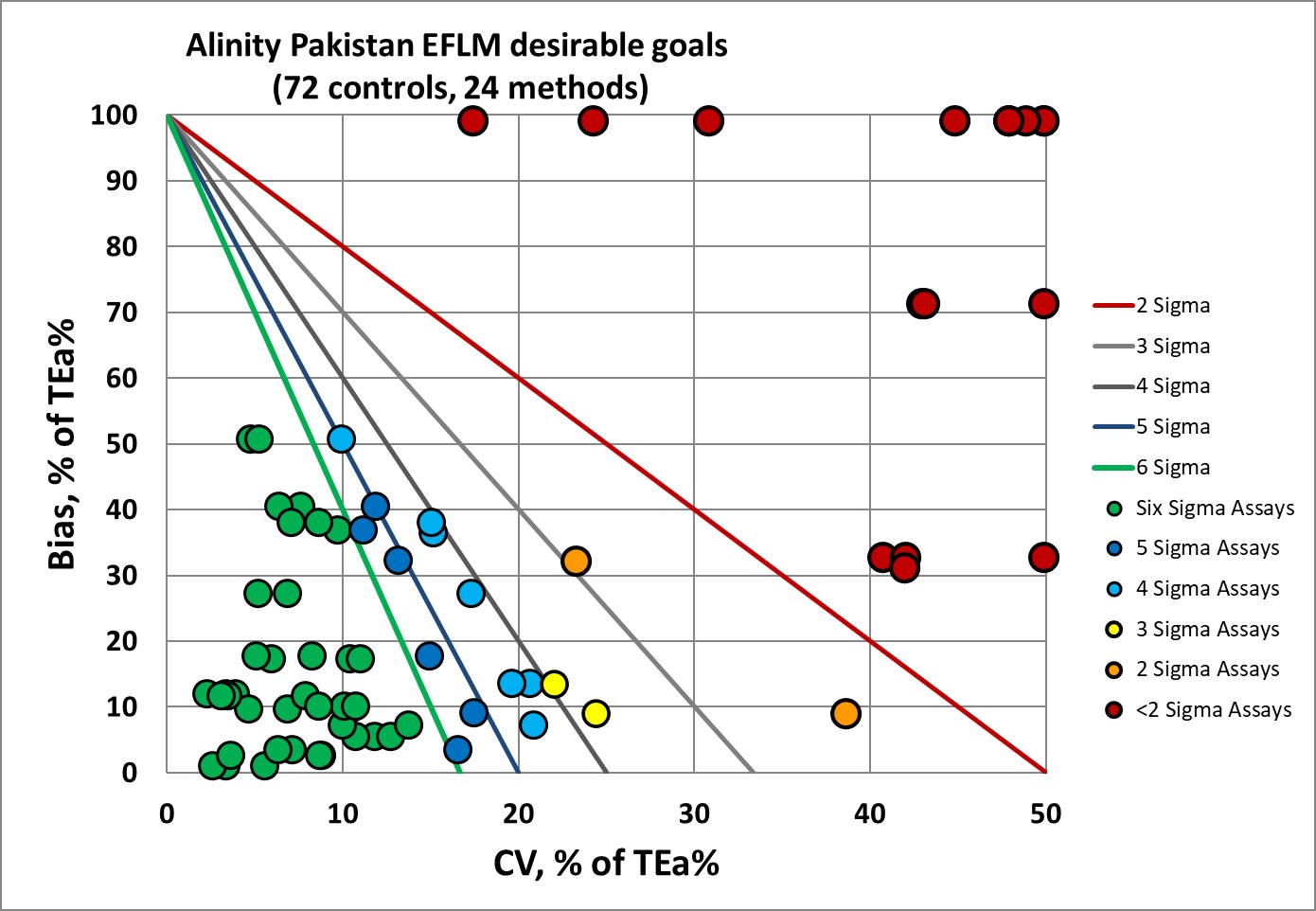
So what happens if we lower the EFLM standards?.
Sigma-metrics according to EuBIVAS-derived MINIMUM performance specifications
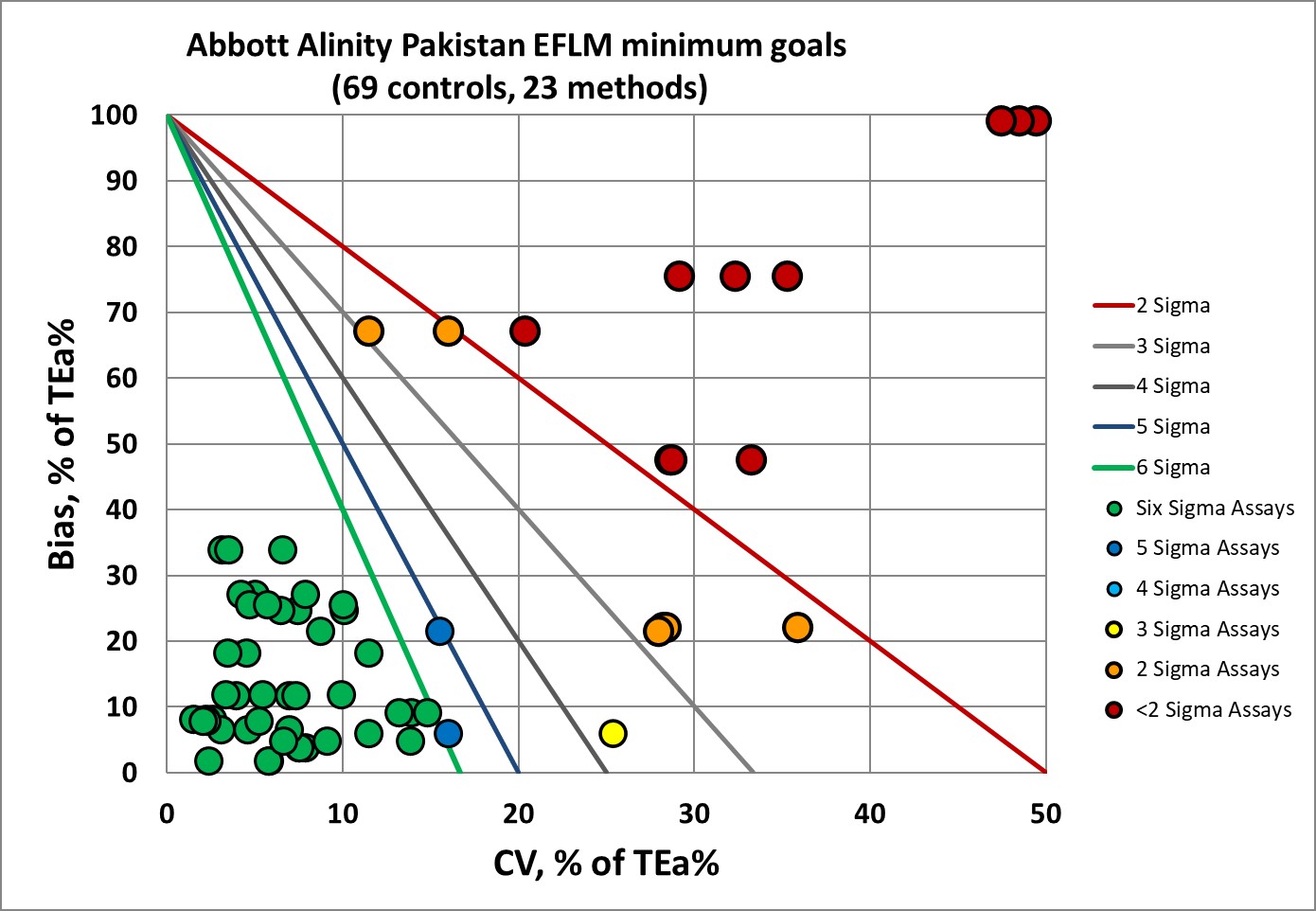
There is a big improvement, no 72% of the performance is in the Six Sigma "bull's-eye", but there continue to be assays that aren't hitting the mark. The number of assays performing below 3 Sigma has dropped to about 23%. Albumin is now on the border between less than 2 and 2 Sigma. Calcium is now in the 2 Sigma zone. Chloride, Magnesium and Sodium remain the problem children. Even the minimum specifications for these analytes are quite demanding.
Next, let's look at the "original" version of the biological variation database. The last version of the database was updated in 2014 by Ricos et al, so we refer to these performance specifications as Ricos 2014 goals.
Sigma-metrics according to Ricos 2014 desirable performance specifications
The original Ricos goals harder on this Alinity ci than the EFLM minimum goals. We still see about 23% of the values below 3 Sigma, but the values above 6 Sigma are now only about 60%.
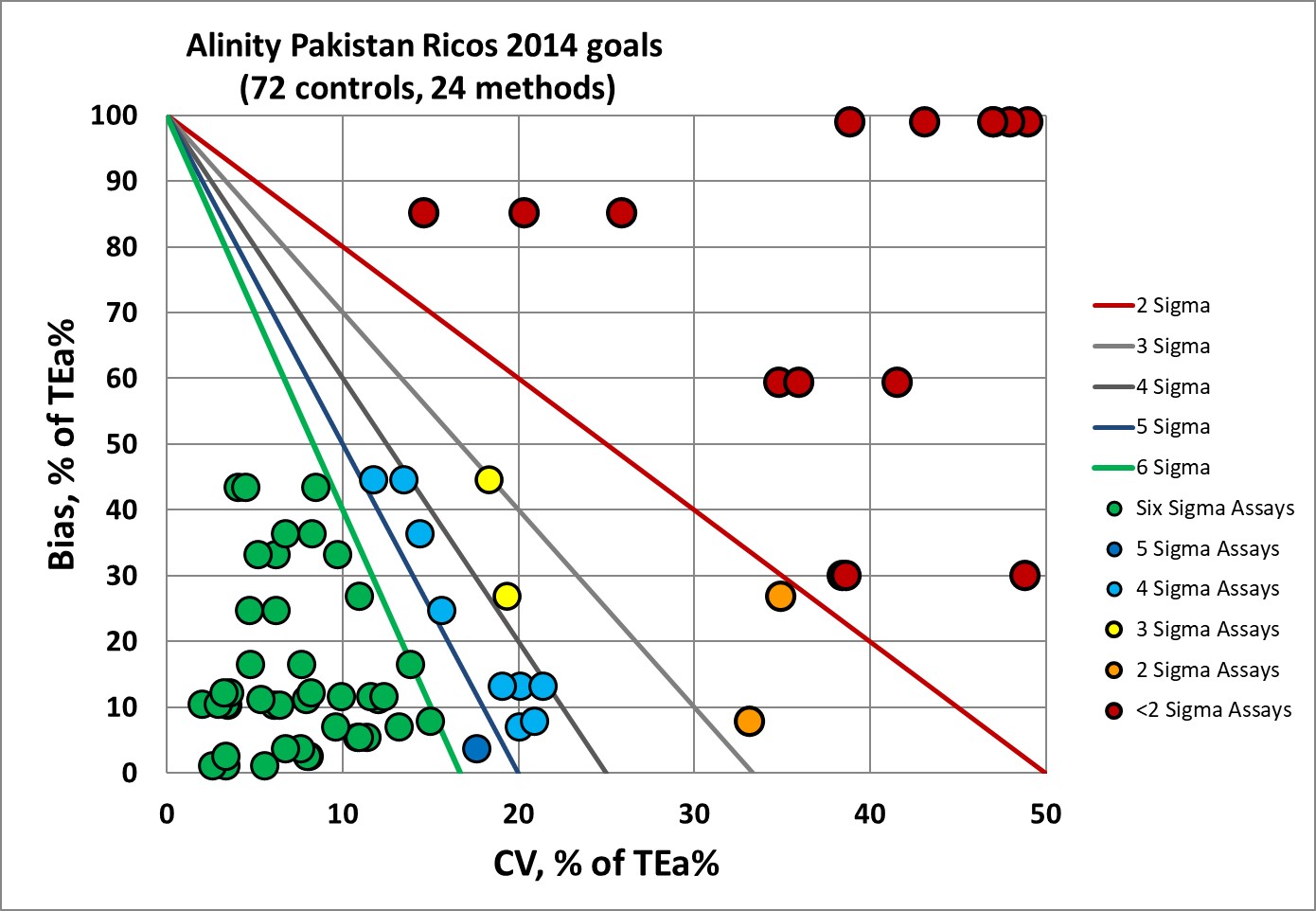
You might be able to guess the assays which don't perform well according to Ricos: Albumin, Calcium, Chloride, Magnesium and Sodium
What happens if we move away from biologically-derived goals toward the CLIA goals, including those newly announced to take effect in 2024? Let's start with the original, now "classic" CLIA goals issued in 1992.
Sigma-metrics according to CLIA 1992 performance specifications
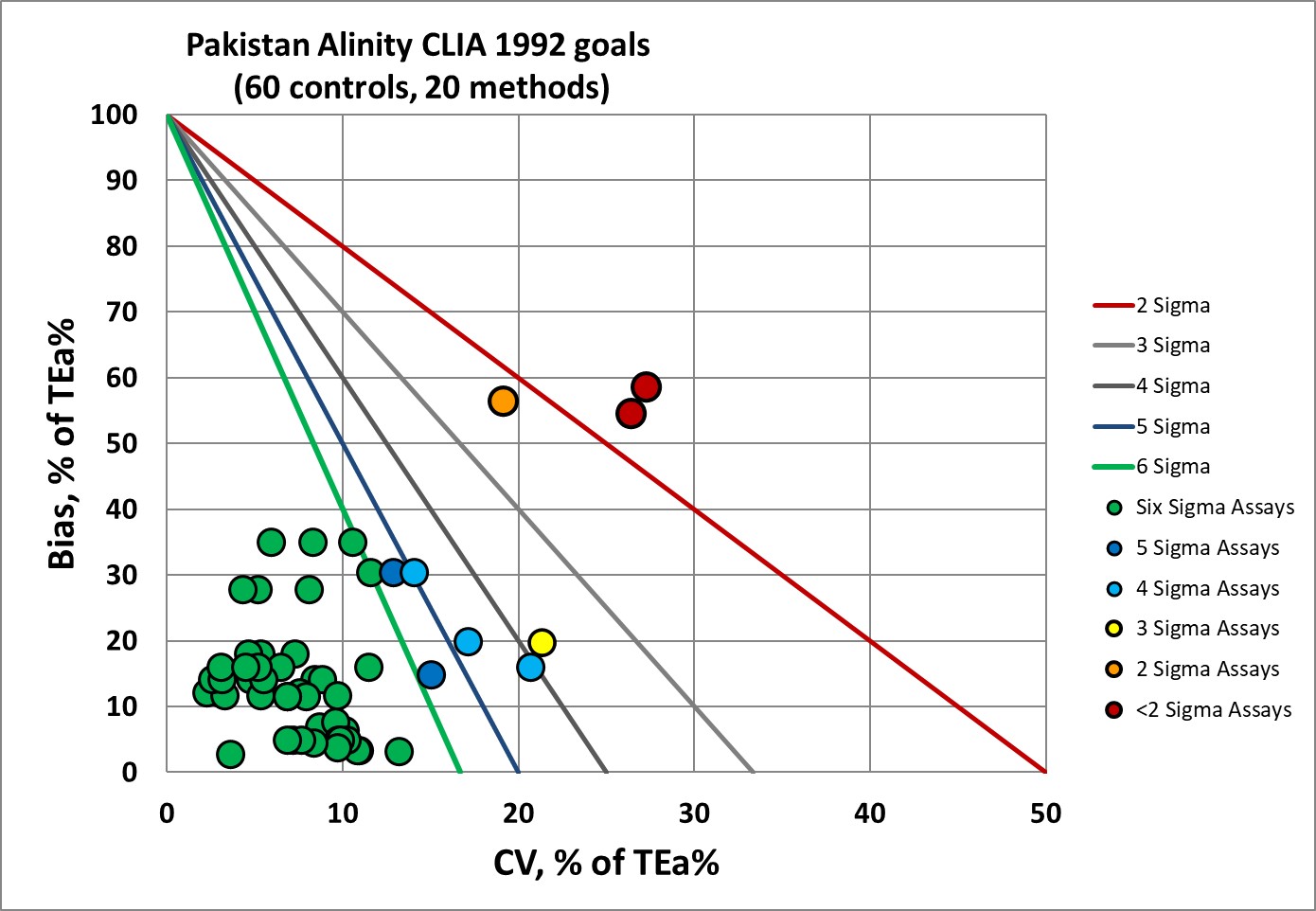
If you judge the Alinity with the oldest specifications, also the most popular ones in the USA, you get an amazing 83% of the performance in the Six Sigma zone. And now only 5% of the assays below 3 Sigma. Can you guess which assay? Yes, it's sodium.
What happens when CLIA tightens its goals?
Sigma-metrics according to CLIA 2024 performance specifications
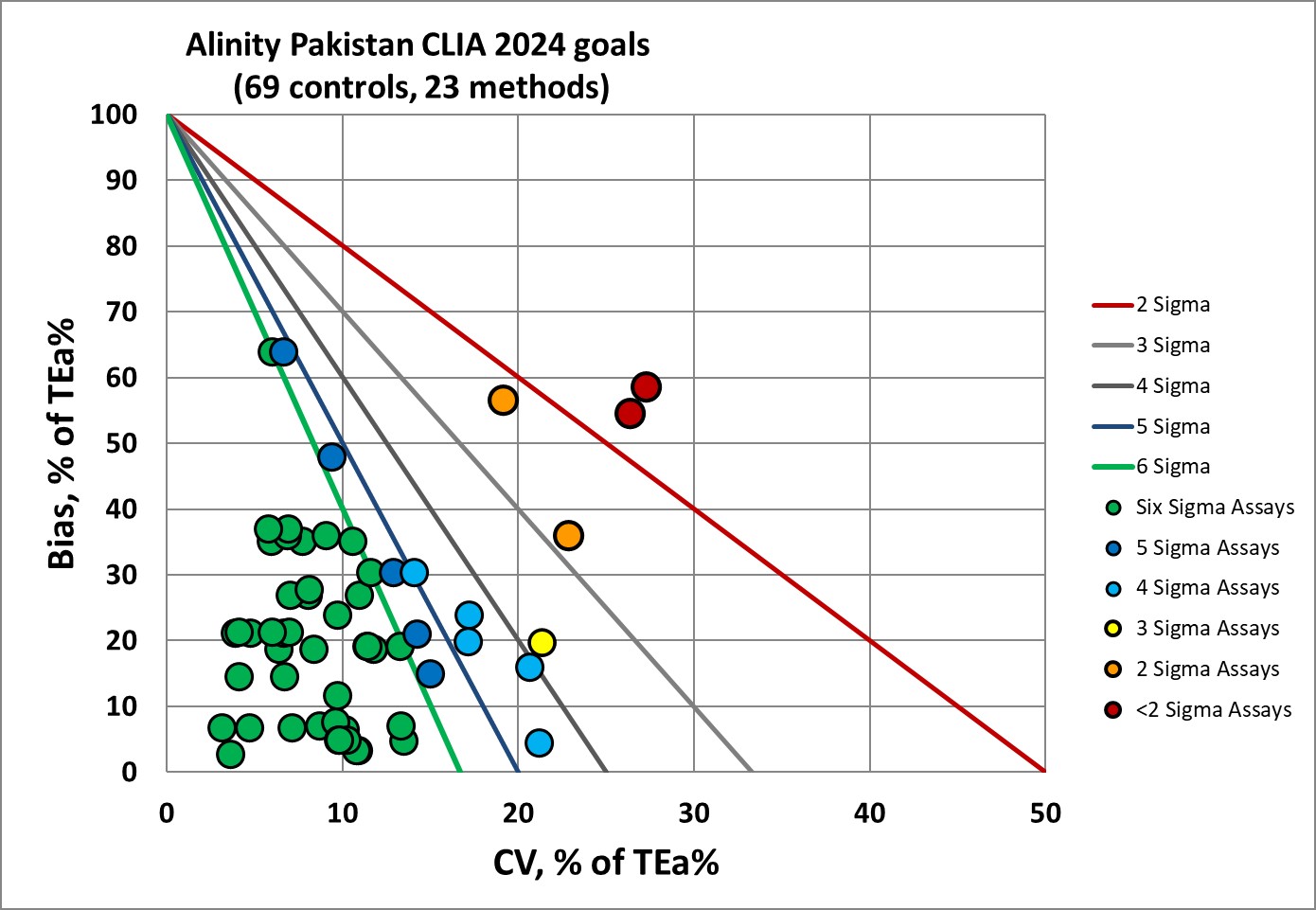
CLIA 2024 is still easier than Ricos and EFLM biological goals of either stripe. 75% of performance is still at 6 Sigma or higher, and little over 5% is below 3 Sigma. Sodium, yes, the persistent bad boy assay, as well as the low level of the Amylase assay.
Conclusion
Of our multimode analyses thus far, Alinity has emerged as the best performer. Alinity seems like CLIA 2024 goals will not be a worry.
The fact that the sodium assay is not acceptable by any standard EFLM, Ricos, or CLIA, no matter the year or setting, may point to an unsettling reality that the goals we are trying to use are not in synch with the capability of the diagnostic industry (the other analyses from other instruments have the same failing).
But remember, the optimal set of goals is not just from one source. A mix of CLIA 2024, Ricos 2014, and EFLM both desirable and minimum is a solution that some don't want to consider, but reality may force us to admit.
